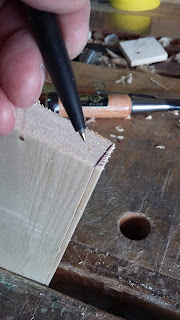 I use to utilize, with ample rotation, all my planes, many of which kept ready to use and sharp.
Today was the Sargent VBM 714 (I restored several years ago) workshift.
VBM stands for Very Best Made
I use to utilize, with ample rotation, all my planes, many of which kept ready to use and sharp.
Today was the Sargent VBM 714 (I restored several years ago) workshift.
VBM stands for Very Best Made
The 7 serie has the particular feature of having the chipbreaker incorporated into the lever cap and adjustable by a screw, without to have to remove any component.
Moreover, its position remains unchanged, in the case the blade was removed for sharpening.
Vintage Sargent planes (VBM planes were made in the second decade of XX century) haven't nothing to envy to the best Stanley planes of that period.
Unlike the Stanley ones, the frog is not adjustable, but this don't create particular discomfort in the use of a 714 (n° 5 equivalent). So, in the smoothing planes of the serie (707, 708, 710), the anti-tearout role is provided only by chipbraker and maybe is this the reason for which the mouth is kept rather abundant (at least in the 714 I have; would be interesting to know if this is true for smoothing models too).
Below all models of 7 serie are listed (with approx. lenght):
707, 7"
708, 8"
 710, 10"
711, 11"
714, 14"
718, 18"
722, 22"
710, 10"
711, 11"
714, 14"
718, 18"
722, 22"










 I just published the book "Pialle che Passione", available on Amazon.
I just published the book "Pialle che Passione", available on Amazon.














 I use to utilize, with ample rotation, all my planes, many of which kept ready to use and sharp.
I use to utilize, with ample rotation, all my planes, many of which kept ready to use and sharp.  710, 10"
710, 10"